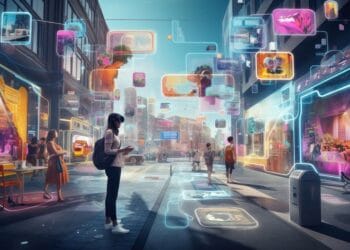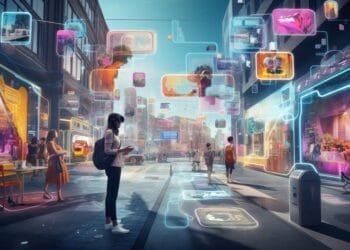In the fast-evolving digital landscape, a powerful and increasingly pervasive trend is reshaping our interaction with technology: personalized tech. Far beyond simple customization, this paradigm involves technologies that learn our preferences, anticipate our needs, and adapt to our unique behaviors, creating bespoke digital experiences that feel intuitive, efficient, and uniquely tailored. From smart recommendations on streaming services to adaptive learning platforms and health monitoring devices, personalized tech is revolutionizing industries, enhancing daily life, and fundamentally redefining the relationship between humans and machines. This comprehensive article delves into the core principles of personalized tech, exploring its foundational components, the diverse technologies that empower its growth, its transformative applications across various sectors, and the critical challenges and immense opportunities that accompany this pervasive shift towards hyper-individualized digital experiences.
What is Personalized Tech?

At its essence, personalized tech refers to any technology or system designed to adapt its functionality, content, or interface to the individual user based on their data, preferences, behaviors, and context. Unlike generic, one-size-fits-all solutions, personalized tech strives to deliver a unique and highly relevant experience for each person. This adaptation can occur in real-time, learning and evolving as the user interacts with the technology.
The primary goal of personalized tech is to enhance user convenience, efficiency, and satisfaction. By understanding individual needs, these technologies can anticipate actions, suggest relevant information, filter out noise, and present content in a way that is most meaningful to the user, thereby fostering deeper engagement and loyalty.
Key characteristics defining personalized tech include:
- Data-Driven: Relies heavily on collecting and analyzing user data (e.g., Browse history, purchase patterns, location, health metrics, interactions).
- Adaptive Learning: Utilizes Artificial Intelligence (AI) and Machine Learning (ML) algorithms to learn from user data, identify patterns, and continuously refine the personalization over time.
- Contextual Awareness: Can adapt based on various contextual factors, such as time of day, location, device being used, or even emotional state (in advanced systems).
- Proactive Recommendations: Often suggests content, products, services, or actions before the user explicitly searches for them.
- Tailored Interfaces: Can modify layouts, menus, or presentation styles to suit individual preferences or accessibility needs.
- Enhanced User Experience (UX): Aims to make technology feel more intuitive, efficient, and enjoyable by removing irrelevant information and presenting what matters most.
A. Foundational Technologies Driving Personalized Tech’s Growth
The rapid advancement and widespread adoption of personalized tech are intrinsically linked to breakthroughs in several core technological domains.
- Artificial Intelligence (AI) and Machine Learning (ML): These are the brains behind personalization.
- Recommendation Engines: ML algorithms analyze vast datasets of user behavior (e.g., viewing history, purchase data, search queries) to predict preferences and suggest relevant content, products, or services. This is foundational for platforms like Netflix, Amazon, and Spotify.
- Natural Language Processing (NLP): Enables systems to understand and interpret human language, allowing for personalized interactions with chatbots, virtual assistants, and adaptive content generation.
- Computer Vision: Allows systems to “see” and interpret visual information, enabling personalized features like facial recognition for secure access, personalized filters in photo apps, or tailored advertisements based on observed products.
- Reinforcement Learning: AI learns optimal behaviors through trial and error, adapting its personalization strategies based on user feedback and engagement.
- Big Data Analytics: The ability to collect, store, process, and analyze massive volumes of diverse user data is fundamental to personalized tech.
- Data Warehouses/Lakes: Infrastructure for storing structured and unstructured user data at scale.
- Real-time Analytics: Processing data as it’s generated to enable immediate personalization and responsiveness (e.g., dynamic pricing, instant recommendations).
- Predictive Modeling: Using historical data to forecast future user behavior, churn risk, or purchase intent.
- Cloud Computing: Provides the scalable, flexible, and cost-effective infrastructure necessary to store and process the enormous amounts of data required for personalization, as well as to host complex AI/ML models.
- Scalable Compute Power: On-demand access to powerful processors for training large ML models and serving real-time predictions.
- Managed Services: Cloud providers offer ready-to-use AI/ML services, making it easier for developers to integrate personalization into their applications without extensive in-house expertise.
- Internet of Things (IoT): The proliferation of connected devices generates a continuous stream of real-time contextual data from the physical world.
- Contextual Data: IoT sensors provide data on location, environment (temperature, light), device usage patterns, and physiological metrics (wearables), enabling highly contextual and anticipatory personalization.
- Smart Home Automation: Devices like smart thermostats learn habits to optimize climate control, and smart lighting adapts to routines.
- User Interface (UI) / User Experience (UX) Design: While not a core technology itself, advanced UI/UX principles are crucial to presenting personalized experiences in an intuitive, non-intrusive, and enjoyable way. This includes adaptive layouts, customizable dashboards, and personalized notifications.
- Edge Computing: Increasingly, personalized tech leverages edge computing to process data closer to the user device. This reduces latency for real-time personalization (e.g., autonomous vehicles adapting to driver behavior) and can enhance privacy by processing sensitive data locally.
Personalized Tech’s Transformative Impact Across Industries
The pervasive influence of personalized tech is fundamentally reshaping operations, driving efficiency, enhancing customer engagement, and creating entirely new service models across an astonishing variety of sectors.
A. Media and Entertainment
Personalization has become the cornerstone of media consumption, transforming how we discover and engage with content.
- Content Recommendation Engines: Streaming services (Netflix, Spotify, YouTube) analyze viewing/listening history, ratings, and genre preferences to suggest highly relevant movies, music, or videos, dramatically increasing engagement and retention.
- Personalized Playlists and Feeds: Music streaming services create dynamic playlists tailored to mood or activity, while social media feeds are curated algorithms to show content most relevant to individual interests.
- Adaptive Advertising: Ads are increasingly personalized based on user demographics, viewing habits, and inferred interests, making them more relevant and effective.
- Gaming Experience: Personalized difficulty levels, dynamic storylines adapting to player choices, and tailored in-game item recommendations enhance player engagement and retention.
- News Aggregation: Personalized news feeds curate articles based on topics of interest, previously read articles, and preferred sources, ensuring users see the most relevant information.
B. Retail and E-commerce
Personalized tech is revolutionizing the retail experience, moving beyond traditional sales to create highly individualized customer journeys.
- Personalized Product Recommendations: E-commerce sites analyze Browse history, purchase patterns, and demographics to suggest products highly likely to be of interest, significantly increasing conversion rates and average order value.
- Dynamic Pricing: Prices can be dynamically adjusted based on individual user behavior, purchase history, location, or perceived willingness to pay, optimizing revenue.
- Customized Offers and Promotions: Tailored discounts, loyalty rewards, and promotions are sent to individual customers based on their specific buying habits and preferences, enhancing customer loyalty.
- Virtual Try-On (AR/VR): Augmented Reality apps allow customers to virtually “try on” clothing, makeup, or place furniture in their homes, offering a personalized visualization experience before purchase.
- Personalized Website Experience: Websites adapt their layout, featured products, and messaging based on a user’s past interactions, creating a unique and relevant shopping environment.
- Chatbots for Personalized Support: AI-powered chatbots provide instant, personalized customer service, answering queries, assisting with returns, and guiding customers through purchases based on their unique needs.
C. Healthcare and Wellness
Personalized tech is transforming healthcare delivery, leading to more precise diagnoses, personalized treatments, and proactive wellness management.
- Personalized Treatment Plans: By analyzing a patient’s genetic makeup, lifestyle, medical history, and response to previous treatments, AI can recommend highly individualized treatment protocols and predict drug efficacy.
- Wearable Health Tech and Continuous Monitoring: Smartwatches and other wearables continuously collect biometric data (heart rate, sleep patterns, activity levels), providing personalized insights into health, fitness, and early detection of potential issues.
- Digital Therapeutics: Personalized apps and programs deliver therapeutic interventions (e.g., for chronic disease management, mental health support) tailored to individual patient needs and progress.
- Personalized Wellness Coaching: AI-powered apps provide tailored fitness routines, nutrition plans, and mindfulness exercises based on individual goals, preferences, and progress.
- Predictive Health Analytics: Analyzing individual health data to predict disease risk, adverse drug reactions, or potential health crises, enabling proactive interventions.
D. Education and Learning
Personalized tech is poised to revolutionize education by adapting content, pace, and teaching methods to individual student needs.
- Adaptive Learning Platforms: AI-powered systems assess student knowledge gaps, learning styles, and progress, then deliver customized content, exercises, and feedback tailored to each student’s unique learning path.
- Intelligent Tutoring Systems: AI tutors can provide one-on-one support, answer questions, explain concepts in different ways, and offer targeted feedback based on a student’s specific struggles.
- Personalized Content Curation: AI can curate relevant learning resources (articles, videos, interactive simulations) based on a student’s interests and learning goals.
- Skill Gap Identification: Analyzing student performance data to pinpoint specific skill gaps and recommend personalized interventions or additional resources.
- Career Guidance: AI can provide personalized career recommendations based on student skills, interests, and evolving job market demands.
E. Financial Services
Personalized tech is enhancing customer relationships, refining risk assessment, and delivering bespoke financial advice.
- Personalized Financial Advice (Robo-Advisors): AI-powered robo-advisors provide automated, data-driven financial planning and investment management services tailored to individual investor goals, risk tolerance, and financial situations.
- Tailored Product Recommendations: Banks and financial institutions use data to recommend personalized financial products (e.g., specific credit cards, loan types, savings accounts) based on a customer’s spending habits, income, and life stage.
- Fraud Detection: AI analyzes individual transactional patterns to detect anomalies that may indicate fraudulent activity, providing real-time personalized alerts.
- Personalized Budgeting and Spending Insights: Banking apps use AI to analyze spending habits, categorize transactions, and provide personalized budgeting advice or saving tips.
- Dynamic Insurance Pricing: Insurance premiums can be personalized based on individual driving behavior (telematics), health metrics (wearables), or lifestyle choices, incentivizing safer behavior.
Challenges and Considerations in the Personalized Tech Era

Despite its immense benefits, the rapid growth of personalized tech presents significant challenges and critical ethical considerations that demand careful attention and proactive solutions.
A. Privacy and Data Security
- Pervasive Data Collection: Personalized tech relies on collecting vast amounts of highly personal data, often continuously and from various sources (Browse, location, biometrics, voice recordings). This raises significant concerns about pervasive surveillance and the erosion of individual privacy.
- Data Breaches: The immense centralized repositories of personal data created for personalization are prime targets for cybercriminals. A single breach can expose millions of users to identity theft, financial fraud, and other harms.
- Lack of Transparency and Control: Users often lack clear understanding of what data is collected, how it’s used, and with whom it’s shared. Providing meaningful consent for complex data flows remains a challenge.
- Re-identification Risk: Even if data is anonymized or pseudonymized, sophisticated analytical techniques can sometimes re-identify individuals by combining disparate datasets, undermining privacy.
B. Algorithmic Bias and Discrimination
- Bias in Training Data: If the data used to train AI/ML models for personalization reflects historical or societal biases, the algorithms will learn and perpetuate these biases, leading to discriminatory outcomes (e.g., in loan approvals, job recommendations, or content filtering).
- Filter Bubbles and Echo Chambers: Personalized recommendation systems can inadvertently create “filter bubbles” or “echo chambers” where users are only exposed to information that confirms their existing beliefs, limiting exposure to diverse perspectives and potentially contributing to societal polarization.
- Manipulation and Dark Patterns: Personalization can be leveraged to subtly manipulate user behavior, for example, through dynamic pricing that exploits individual price sensitivity, or “dark patterns” in UI design that nudge users towards certain choices.
C. Accountability and Transparency
- Black Box Problem: The complexity of advanced AI algorithms makes it difficult to understand how they arrive at specific personalized recommendations or decisions. This lack of transparency hinders auditing, explanation, and rectification of errors or biases.
- Who is Responsible?: When personalized tech leads to negative outcomes (e.g., a biased recommendation, a security lapse), assigning clear accountability among developers, deployers, and data providers can be challenging.
- Explanations for Personalization: Users often don’t understand why they are seeing certain recommendations or personalized content, leading to a lack of trust.
D. User Experience and Psychological Impact
- Personalization Fatigue: Constant personalization and recommendations can sometimes feel overwhelming or intrusive, leading to “personalization fatigue” where users disengage.
- Loss of Serendipity: Over-personalization can limit exposure to new ideas, diverse content, or unexpected discoveries, narrowing a user’s digital experience.
- Dependence and Addiction: Highly personalized experiences can be incredibly engaging, raising concerns about digital addiction and the potential for technology to diminish human autonomy and critical thinking.
- Digital Identity and Self-Perception: The way personalized algorithms reflect or shape our digital identity can influence self-perception and social interactions.
E. Technical Challenges
- Data Quality and Integration: Ensuring high-quality, consistent data from diverse sources is crucial. Integrating data from disparate systems for a holistic user profile is technically challenging.
- Scalability: Delivering real-time, highly granular personalization to millions or billions of users requires immense computational power and scalable infrastructure.
- Model Explainability for Complex AI: Making highly accurate yet explainable AI models for personalization remains a significant research challenge.
- Real-time Contextual Awareness: Accurately gathering and interpreting real-time contextual data from various devices and environments for truly adaptive personalization is complex.
Conclusion
Personalized tech is rapidly growing as a defining characteristic of our digital age, fundamentally transforming how we interact with technology and the value we derive from it. By learning our preferences, anticipating our needs, and adapting experiences to our unique profiles, it offers unparalleled levels of convenience, efficiency, and engagement across virtually every sector. From the curated entertainment we consume to the precision healthcare we receive and the intelligent financial advice we seek, personalized tech is undeniably enhancing our daily lives.
However, the journey towards a truly hyper-personalized future must be navigated with careful consideration and a strong ethical compass. Addressing the formidable challenges of privacy erosion, algorithmic bias, data security, and ensuring user autonomy is essential for its long-term success and societal benefit. By fostering collaboration among technologists, policymakers, ethicists, and the global community, we can ensure that personalized tech serves as a powerful force for good, building a smarter, more responsive, and ultimately more human-centric digital future. Personalized tech isn’t just growing; it’s defining the very essence of our digital experience.












